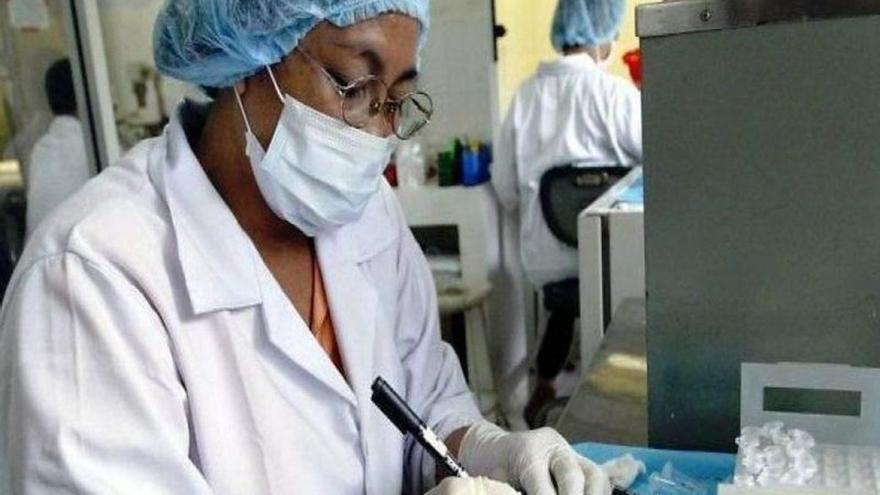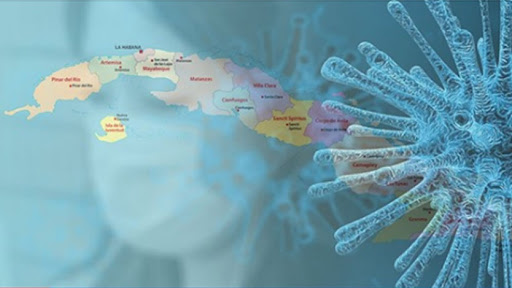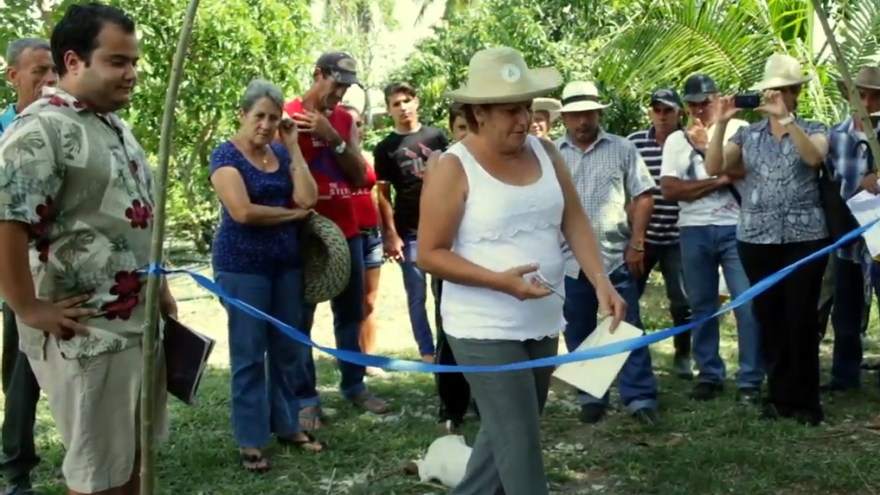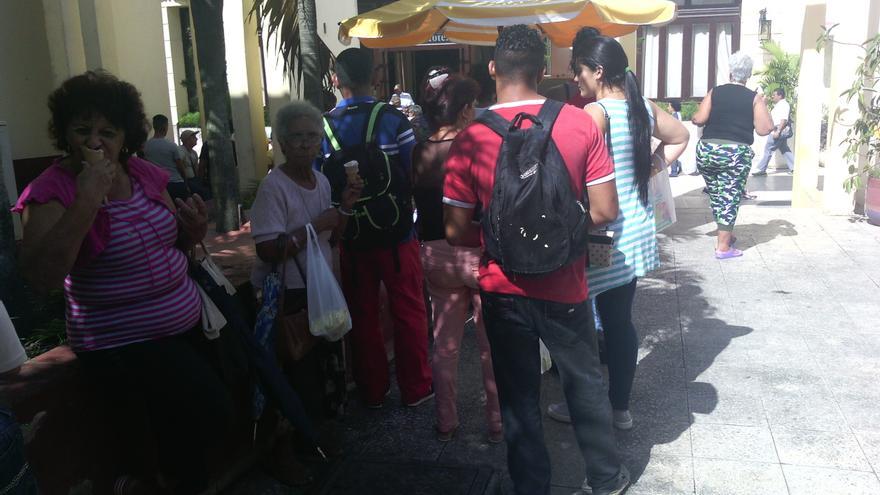Iván García, Havana, December 9th, 2019 — This interview is the fruit of much bargaining. In various profiles that Journal of The Americas aims to publish on independent Cuban journalists of different generations, the name Monica Baro is underlined in red.
The plan was to open the season with an interview of the brilliant young reporter from Havana, who at 31 years of age publishes El Estornudo (The Sneeze), a digital publication of narrative journalism. But Monica was impossible to catch. When she was not travelling abroad, she had a lot of work. Time and again she postponed the date of the interview. I refused to give up.
Finally, on Tuesday, December 3rd, we managed to meet at the Cafe Fortuna, on First and 24th Street in Miramar, a neighborhood in the west of Havana caressed by the breeze from the Atlantic Ocean. The locale was decorated in a vintage style, dimly lit with poems by Chaplin adorning the walls. The servers were dressed in 1950s sailor outfits. continue reading
Twelve minutes after the agreed-upon hour, Monica appeared in black jeans covered in patches. Her hair hung loose and she wore a plastic Made in China watch, a white pullover emblazoned with an image of Frida Khalo, a smile and glasses that gave her a quirky, intellectual air. Monica was in her element.
I heard her name mentioned for the first time in 2014. It was a hot afternoon in summer, in a bar a stone’s throw from the Bay of Havana, where we, a group of independent journalists, would go to drink beers once a month. We would speak about our families, baseball and soccer, as well as local and international politics. But the majority of our time we dedicated to talking about journalism. I don’t recall if it was Jorge Olivera or Victor Manuel Dominguez who mentioned an interview that a Monica Baro had published in OnCuba.
When I read the interview, I found myself more interested in the questions the reporter was asking than the interviewee’s responses. Reading the byline at the end I learned that the reporter was a recently graduated journalist. She had worked in the publication Bohemia and at the Institute of Philosophy. A short while later, as I was revising articles in the Wi-Fi park of La Vibora, I stumbled across Monica again, this time in the independent newspaper Periodismo de Barrio, with a report on a woman who lived in extreme poverty in deep Havana.
Already, journalist cliques were babbling about Monica Baro. It was clear that she was in another league. And then the awards began to pile up. The last, the Gabo Prize, she received in October 2019 in Colombia for her investigation ‘La sangre nunca fue amarilla‘ (The Blood Was Never Yellow), published in Periodismo de Barrio in February of this month.
But Monica remained shrouded in her natural humility, dodging spotlights and praise. When she sat on the stool at Cafe Fortuna, after the usual greeting, she ordered a refreshment. I made the most of it and told her she was more difficult to trap than a politician. She smiled, tilted her head and we began to film.
Iván García: Monica, are you planning to leave, to emigrate?
Monica Baro: Not so far. I am not sure if I will stay in Cuba indefinitely, it is impossible to tell. You never know where you’ll end up.
Iván García: I am going to describe to you two hypothetical scenarios. One, Cuba 2059, Monica, grandmother to a couple of grandchildren, prepares to cover the centennial of the disaster called the Cuban Revolution for El Esturnudo. Second scenario, Monica, 71 years old, already retired, remembered for her contributions to Cuban narrative journalism. Which scenario do you think the future will bring? Do you sincerely believe there is a solution for Cuba?
Monica Baro: I believe so. There are those that think that Cuba will change in two years. Others say five, ten. The truth is that I don’t know how much time Cuba will need to democratize and become a country that respects political liberties and freedom of expression. To be a decent country, where people can have a future and develop themselves openly. But I persevere. This is not something that gives me pause. I think that one has to be in a place one wants to be and is happy.
If I am here it is not because I feel a certain commitment to a certain cause or to the democratization of the country. I am in Cuba because the work that I do here makes me happy. The day that this work no longer makes me happy, I’ll leave.
For a long time the government, and the most rancid left on the continent, have wanted to inoculate us with the idea that you have to sacrifice yourself and everything for the cause and put the interests of society in front of the interests of the individual. And I believe that this is not healthy for any cause. I believe that causes have to be the ones that make people happy.
If you are defending human rights, the freedom of expression and independent journalism, it is because it makes you happy. When I worked for the review Bohemia, I interviewed Pepe Mujica at a CELAC event, and something he said stuck with me: “A generation cannot sacrifice itself for a utopia.”
It is the same on the individual level. You cannot sacrifice yourself for a utopia. For me, utopia is the present. It is not the future. It’s today. And for me, since I graduated in journalism in 2012, every day that I have been in Cuba I have been living in my own utopia, my happiness.
Iván García: Independent, free and alternative journalism, as you call it, arose at the end of the 1980s. Afterward, in the 1990s a number of independent journalism agencies were established that abused the use of the opinion column. But, at the same time, street journalism began, with reports and chronicles from that other island that the regime tries to ignore.
In 2007 the blog Generation Y was started by Yoani Sanchez, which undoubtably marked a new era in freelance journalism with the appearance of new digital publications.
With the relaxation of tensions of the Obama era in 2014, a wave of talented journalists surged forward, exploring that which I call the new Cuban narrative journalism. This is a deliciously different kind of journalism of undeniable quality, and it has awakened suspicions in some independent journalists of the barricade, decidedly anti-Castro. It is said that this new group does not compromise, that they are a fifth column that rejects the current themes of Cuban society and look a bit from above the shoulders of the rest. What is your take on this topic?
Monica Baro: I think this is another political miseducation that we have inherited from the government. We think that we have the authority to judge the political and social leanings of other people. In issuing judgement, we believe ourselves to be the judge of others. It is sad, a culture that we have to overcome, to be constantly questioning that if you are committed to this, I am more committed than you are, a logic that really shocks me.
I make a fair effort not to fall into this vicious cycle, but I don’t want to claim that I am a stranger to this culture. I was educated in Cuban schools, I was indoctrinated, we are part of the same society. One should always question their way of interacting with others, their way of conversing, their way of treating people who are different and think differently than you. And it shouldn’t be that you put yourself in a position of moral superiority to issue judgement, since those who judge believe that they have the moral superiority to do it.
Iván García: Do you believe that this has happened?
Monica Baro: Yes, of course. All those who can say that El Estornudo, Periodismo de Barrio or El Toque are not more radical media, because they don’t deal with more political themes, are obviously making judgements. And for me there is a logical explanation: these media are drawing a border between activism and journalism. I am aware that there are some media that do both simultaneously. I understand that there are publications that engage in political activism. I myself have engaged in political activism on social media in defense of political liberties, freedom of the press and of expression.
In a way, when you create independent journalism in a country where there is no freedom of the press you are defending the right to freedom of the press and freedom of expression. But you have to know there is still a border between journalism and activism. It is important to respect this, as it is what guarantees that what you publish as a journalist has more credibility.
Genre journalists are here for a reason. When you want to give your opinion, you do so. When you go to investigate, you investigate. You demonstrate with facts, you contrast your sources, using various sources if you are going to denounce something.
You try to respect these genres that are here for a reason. And also respect a profession that has rules and norms that are not by choice. They are there to ensure that, first, you protect yourself, second, you protect your sources, and, third, the information that you publish has the effect you are looking for. This is not to say that a journalist, when they leave their office, goes and serves in a political party, of course. But you have to know where the limits are.
Iván García: I am going to give you some bad news and the good news. Digital journalism, just like traditional journalism, has not recovered from the crisis that the introduction of new technology created. The majority of media has not found an effective business model. And the worst part is that, for the past ten years, even now, Chinese media has been using robots as presenters.
They say that artificial intelligence and robots will substitute for a large number of journalists, in particular those who write news. I suspect that the journalists that will remain are those who can tell stories differently, to be read by an audience of readers nostalgic for the Sunday paper.
The good news is that this kind of advanced technology will take a while to reach Cuba. Has the though ever crossed your mind to abandon journalism and take refuge in literature or poetry?
Monica Baro: I don’t know. I don’t think I’ll ever leave journalism. What I want is to tell stories, and journalism gives me this space. Nonetheless, at some point I would love to write literature. In fact, when I first started to write as a child of eleven years, I did not start as a reporter. I liked to write stories and novels. When I was twelve I wrote pages and pages of things. This was where I started, with fiction. But my main interest is telling stories. I would love to write screenplays, but without completely giving up on journalism. The only difference would be that one contains fact and the other fiction.
Iván García: Do you think that social media is harmful to serious journalism?
Monica Baro: Social media is a tool used by people. I do not see it as something abstract, as it has its own life. I do think that we have to educate ourselves about the use of social media, especially when it comes to the consumption of news and information.
Many people say “I read it on the internet,” but the internet is not a source of information. We have to know how to identify which sources are trustworthy, why they are trustworthy or not. People have to learn how to consume journalism. To look up the sources and citations from news articles.
I think that schools should include, as another required subject, a course on how to protect yourself on the internet and how to consume information from the internet. But I don’t believe that journalism will disappear, as journalism does not just inform people but also helps them to understand. Literary journalism is trying to provide something different, other focuses. It does not just aim to give cold hard facts.
Iván García: But then this happens: a joke or fake news generates thousands of comments on social media. Regardless, a deep and entertaining piece like ‘La sangre nunca fue amarilla’, which you published in Periodismo de Barrio, and was awarded the Gabo Prize for Journalism, barely had comments on the site.
Feedback, when there is any, stays in the intellectual world. And then something strange and dangerous happens–those who read your article begin to think themselves reporters and communication professionals. And these articles never reach the people they were aimed at. Not even through reposts.
Monica Baro: This report, ‘La sangre nunca fue amarilla’, took me three years, between research and editing. Of course at times one can feel a bit decieved. But I keep insisting.
The server brought something to eat. Monica mentioned that she’s a fan of cinema.
“From when, on the 5th of December, the annual Cinema Festival starts in La Habana and until it ends on the 15th, I turn off my cellphone. I love classic black-and-white films. Every night I go to see a movie.”
She enjoyed Joaquin Phoenix’s version of the Joker. She loves Tarantino.
“Have you seen his latest film, Once Upon a Time in Hollywood?” I asked.
“No, how was it?” She wanted to know.
“Very good, Tarantino in his purest form.” I said.
We finished eating and returned to the task at hand. She told me that State Security had detained her only once.
“It was in Guantanamo, in 2016, during Hurricane Matthew. I am also regulated (restricted from travelling abroad). At least for now.”
She doesn’t see herself as a political figure. “It’s not my responsibility. Politicians, democracy, have to come to different agreements to be able to govern. I prefer to judge them as a citizen from the perspective of journalism.”
She has her habits and manias. “Before sitting down to write, preferably in the morning, I have to bathe, then I drink coffee and burn some incense, in that order. I don’t have to isolate myself. I can write just the same in an airport at peak hours. I read a lot, at all times,” she confessed.
She respects political columnists. She thinks that they should have broad historical knowledge, a lot of information and a good analytical capacity to write. But they also have to be willing to jump in and give their opinion in any them when needed. Monica Baro is one of the forty Cuban women who signed a letter petitioning an Integral Law against Gender Violence and last November she presented to the National Assembly of Popular Power.
Night had fallen in La Habana. I bid farewell to one of the young voices for change in Cuba. A woman fighting for a different kind of journalism. And for democracy in her country.
Text and Photography: Iván García
Note: On the 5th of December, after this interview, it was announced that four Cubans, the journalists Mónica Baró Sánchez and Carlos Manuel Álvarez, the filmmaker José Luis Aparicio Ferrera and the environmental entrepreneur Alexander López were included in the list of 100 young Latinos who believe in and inspire a better world, created by the periodical Avianca. About Monica, the Colombian publication wrote that the Cuban woman, connected to alternative media like Periodismo de Barrio, El Estornudo and El Toque, won the Gabo Prize of Journalism in 2019 in the Best Article category for her report “La sangre nunca fue amarilla.”
Translated by: Geoffrey Ballinger

![]() 14ymedio, Havana, 25 February 2021 — Fabrizio Chiodo, the only foreign researcher involved in the development of Cuba’s Soberana 02 vaccine for Covid, reported to the international press this Wednesday on the promising development of the vaccine candidate, which will pass to phase 3 of clinical trials this coming Monday. This announcement confirmed that Cuba will be the last country on the continent to begin immunizing its population.
14ymedio, Havana, 25 February 2021 — Fabrizio Chiodo, the only foreign researcher involved in the development of Cuba’s Soberana 02 vaccine for Covid, reported to the international press this Wednesday on the promising development of the vaccine candidate, which will pass to phase 3 of clinical trials this coming Monday. This announcement confirmed that Cuba will be the last country on the continent to begin immunizing its population.





